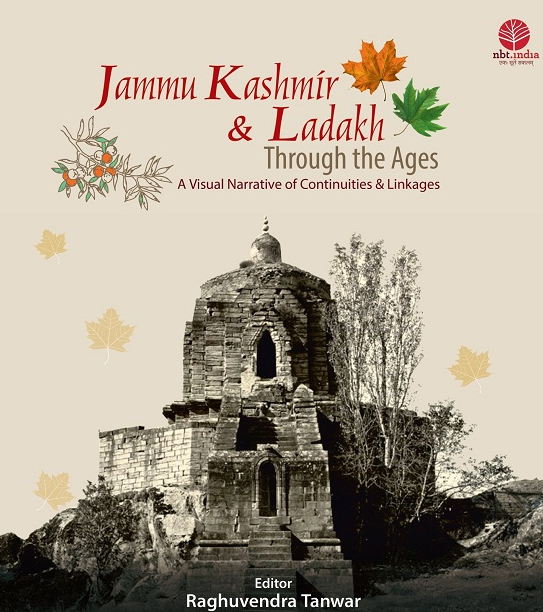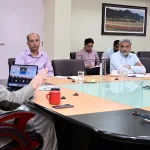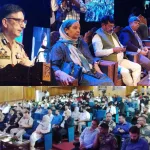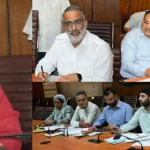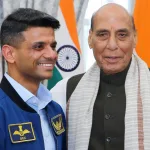BOOK REVIEW
It has been never ever been an easy task to undertake a journey be it literally on ground or in literary circles that has been trudged earlier on by millions of footfalls or countless of literary giants who having weaved their side of story of a given area or topic; leave very little for future endeavors. The latest literary foray undertaken jointly by the NBT & ICHR (National book trust & Indian council of Historical research ) in J&K as well as Ladakh is albeit ‘New wine in a new bottle’. The twin agencies of our nation state have a long and checkered history laced with excellent coverage of India’s forays into the literary world often leading from the front showcasing what the country is in the present times as also in the times of yore.
J&K as well as Ladakh adorning the country’s so called ‘crown’ has the USP of never being out of the limelight from times immemorial partly owing to its unique geographical positioning in the Asian continent sitting at the cross roads of twin civilizations India & China; and secondly being the cynosure of most of the invading armies of the world. J&K as well as Ladakh have been shaping up India’s geo-political as well as strategic outreach in the neighborhood for centuries. The region has been up and about the Indian sub-continent’s planning radar for the last 5 years or so (abrogation of article 370 & 35 A) in a more pro-active manner and the latest book by NBT should be seen in the light of these developments.
The significance of this literary exposition on J&K as well as Ladakh lies in the fact that it is for the first time that a national agency like the NBT has taken upon itself to document India’s geo-cultural unity from Kashmir to Kanyakumari. Most of the writers of eminence whether India based or even Ex-India have precisely done the opposite; i.e. actively fanned myths of India’s disunity by quoting a raft of historical untruths.
The book in particular highlights Kashmir’s role in India’s history dating back for over 8000 years. The book provides an extensive overview of the region’s history, spanning over three millennia. Divided into seven (7) sections the book covers 3000 year’s region’s history with an equally impressive array of illustrations that are arranged chronologically and thematically. This masterpiece of literature fascinatingly meanders through the 212 (two hundred and twelve) pages with skillful deftness unfolding a fascinating story from the earliest times to abrogation of article 370. The photographs, illustrations as well as numerous exhibits explain how these three regions of Jammu, Kashmir & Ladakh have flourished in the larger mosaic of India’s cultural, linguistic and ethno centric diversity with aplomb.
The book documents the rich heritage of Kashmir and Ladakh covering scripts, knowledge systems, spiritual connect, culture and languages. Kashmir was a crucial link in the journey of Buddhism from Nepal to Bihar and onwards to Afghanistan. The region played a pivotal role in shaping modern Buddhism after Lord Buddha’s teachings. Places like Kanzalwan in the Gurez valley abutting the famous Kishan Ganga river still has dime a dozen Buddhist caves that are yet to be discovered in their entirety.
As if this is not enough sculptures from Drass and Ladakh, stupas and temple ruins destroyed by countless invaders too find a mention in this seminal book on J&K and Ladakh. Sanskrit references from the historical text ‘Rajatarangini’ are also part of this book. The recent ASI (Archeological Survey of India) findings in Gilgit/ Baltisthan of Pakistan that depict some rock edicts having Sanskrit inscriptions dating back to 6/ 7th century AD Should leave no body in doubt that the Hindu cum Buddhist linkages to northern Pakistan is just not a quirk of fate but an established historical fact derived and based on sound empirical data curated from the sites and only now coming to limelight.
In the similar vein the Buddhist sculptures, rock edicts & inscriptions that lie dotted all along the Gilgit –Baltisthan landscape and now under the hammer of development unleashed in the form of CPEC ( China Pakistan economic corridor) is conspicuous by its reference in this book. Sadly this latest aspect fromGilgit/Baltisthasn doesn’t find mention in this historical treatise as mentioned by me and merits as an important adjunct in future editorial editions of this book as and when they occur. The ‘land of Kashyap’ aka Kashmir was always at the forefront of etching an exclusive script of historical cum spiritual importance that had its reverberations felt far and wide in the sub-continent. These reverberations often crossed the mighty Karakorum & Hindu Kush ranges only to be visible in the arid landscape of Afghanistan in the form of Buddhist caves at ‘Bamian’ that were put to destruction under the guns of Taliban few decades back. Ironically the same Taliban dispensation is now at the forefront of conservation efforts of these relics of the past. Time will only be the testimony in this case.
With the first edition of this masterpiece just now released by the honorable Home Minister Mr Amit Shah with Mr Dhamendra Pradhan the Union Education Minister and chairman of the ICHR Mr Raghuvendra Tanwar in attendance, the seminar cum exhibition is a telling comment on India’s seminal commitment in safeguarding its literature treasure trove. With a paperback binding, containing 212 pages in all and dimensions bearing 28.5 inches x 24.5 inches as also with ISBN code displayed in broad capitals this book is a veritable delight for general readers as well as those history buffs who believe in nothing short of getting this masterpiece first off the reader’s shelves.
Priced at Rs 865/ the book does not seem to weigh much heavy on the pockets of avid readers. It is a must buy for individual scholars, research institutions of the ilk IIAS (Indian Institute of Advanced Studies). It is only such masterpieces so painstakingly structured that have the potentials of opening the innermost vistas of learning of masses and the student fraternity as such.
I only hope that the latest education policy( NEP-2020) so much advertised upon by the Modi government includes such books in its curriculum and forms part of the NCF (National curriculum framework) that will go a long way in correcting the distortions of Indian history so assiduously heaped upon by the select few on a humongous many of this country. The sooner the better.
(The writer is retired army officer and a regular scribe of Rising Kashmir. He can be approached on his email: [email protected])


